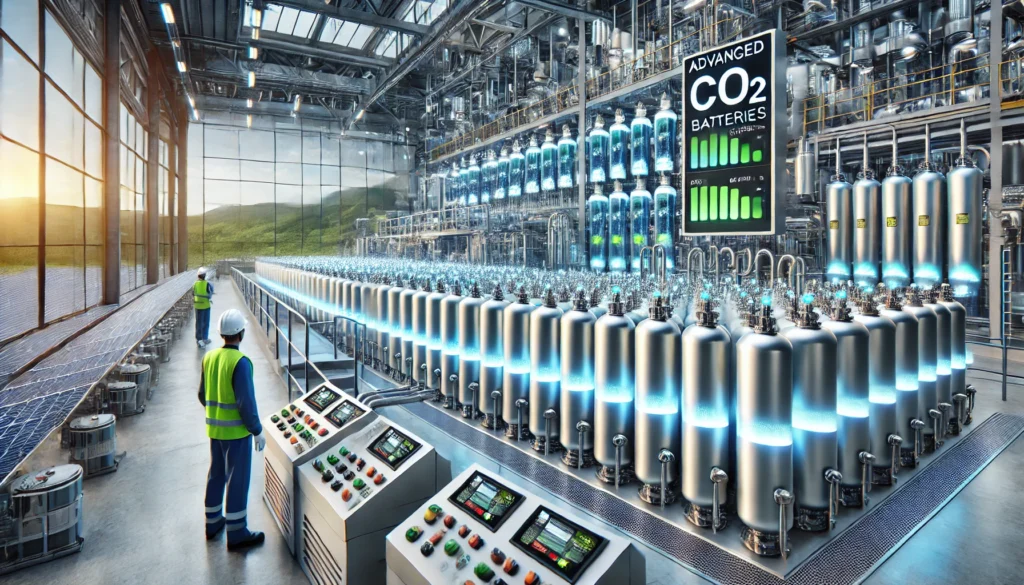How CO2 Batteries Are Shaping the Future of Energy
Summary
- Addressing Energy Challenges: The CO2 battery provides a solution to the intermittency of renewable energy sources like solar and wind.
- How It Works: A closed-loop system stores renewable energy by compressing CO2 into liquid form, later converting it back to gas to generate electricity.
- Environmental Sustainability: CO2 batteries reduce reliance on environmentally harmful raw materials like lithium, nickel, and cobalt.
- Cost-Effectiveness: With projected storage costs as low as $50/MWh, CO2 batteries are significantly cheaper than lithium-ion alternatives.
- High Efficiency: Achieves 75-80% round-trip efficiency, comparable to pumped hydro storage and better than compressed air systems.
- Long Duration Storage: Provides energy for up to 24 hours or more, ideal for grid stability during low renewable energy generation periods.
- Scalability and Flexibility: Modular design allows deployment across diverse geographies using existing supply chains.
- Reducing Pollution: Addresses environmental concerns by eliminating hazardous mining practices and minimising fossil fuel dependence.
- Challenges: Requires more land than lithium-ion batteries and has slightly lower efficiency in short-duration storage scenarios.
- Future Potential: Promises a cleaner, more sustainable energy grid when integrated with renewable systems.
Harnessing the Power of CO2 Batteries: A Sustainable Future for Energy Storage
As the world grapples with energy issues, the reliance on coal and petroleum-based energy sources continues to pose severe threats to our environment. The urgency to transition to cleaner energy solutions, such as solar and wind, has never been greater. However, these renewable sources come with a critical challenge: intermittency. This necessitates efficient energy storage systems to bridge the gap between supply and demand. Enter the CO2 battery, a revolutionary innovation that not only stores energy efficiently but also helps combat climate change.
Understanding the CO2 Battery
The CO2 battery, pioneered by the Italian startup Energy Dome, offers a novel approach to energy storage by leveraging carbon dioxide. Here’s how it works:
- Charging Process:
- Renewable energy surplus drives a motor that draws CO2 from a massive dome-shaped gas holder, where it’s stored at ambient temperature and pressure.
- The CO2 is compressed into a dense liquid and stored in high-pressure vessels at room temperature.
- Compression-induced heat is captured and stored in thermal units for later use.
- Discharging Process:
- The stored heat converts the liquid CO2 back into gas.
- The expanding CO2 drives a turbine, generating electricity that is fed back to the grid.
- The CO2 is then returned to the dome to complete the cycle.
This closed-loop system ensures that CO2 remains contained, requiring only a one-time charge of gas to last the system’s 30-year operational life.

Benefits of CO2 Batteries Over Conventional Batteries
1. Environmental Sustainability
- Unlike lithium-ion batteries, CO2 batteries do not rely on mining rare earth metals like lithium, nickel, or cobalt, which have severe environmental and ethical implications.
- The system repurposes carbon dioxide, a major greenhouse gas, as the working fluid, helping mitigate its environmental impact.
2. Long Duration Energy Storage
- CO2 batteries can store energy for up to 24 hours or longer, making them ideal for addressing the intermittency of solar and wind power.
- They maintain their storage capacity over their 30-year lifespan, unlike lithium-ion batteries, which degrade over time.
3. Cost-Effectiveness
- Energy Dome projects the levelized cost of storage (LCOS) for CO2 batteries to be as low as $50/MWh, significantly cheaper than lithium-ion batteries ($131-$232/MWh).
- The use of off-the-shelf components like compressors and turbines simplifies the supply chain, further reducing costs.
4. High Efficiency
- With a round-trip efficiency (RTE) of up to 75-80%, CO2 batteries rival other long-duration storage solutions like pumped hydro storage.
- Unlike compressed air energy storage (CAES), CO2 batteries do not require large underground caverns, making them more scalable.
5. Scalability and Flexibility
- Modular design allows customization to meet various energy storage requirements.
- Can be deployed in diverse geographic regions using existing industrial supply chains.
Tackling Environmental Pollution
The shift from fossil fuels to renewables like solar energy is a critical step in reducing greenhouse gas emissions. However, traditional energy storage solutions like lithium-ion batteries come with their own environmental concerns, such as resource-intensive mining and hazardous waste. CO2 batteries address these issues by:
- Eliminating reliance on scarce raw materials.
- Providing a cleaner and more sustainable alternative for large-scale energy storage.
- Helping reduce the need for fossil fuel-based backup power.
By integrating CO2 batteries into renewable energy systems, we can create a cleaner, more sustainable energy grid that minimizes environmental pollution.
A Practical Solution for Renewable Energy Storage
CO2 batteries offer a practical and environmentally friendly solution for long-duration energy storage. Their unique benefits, including cost efficiency, scalability, and reduced environmental impact, make them a promising alternative to conventional batteries. While challenges like land requirements remain, the potential of this technology to revolutionize energy storage and support a greener future is undeniable.
Conclusion
As we transition to renewable energy, efficient storage systems are essential to ensure a stable and reliable power supply. CO2 batteries not only solve the intermittency problem but also offer a sustainable alternative to traditional energy storage methods. By harnessing the power of carbon dioxide, we can turn a major climate change culprit into a key ally in the fight against environmental pollution. The CO2 battery represents a step forward in achieving a cleaner, greener, and more sustainable energy future.



Post Comment